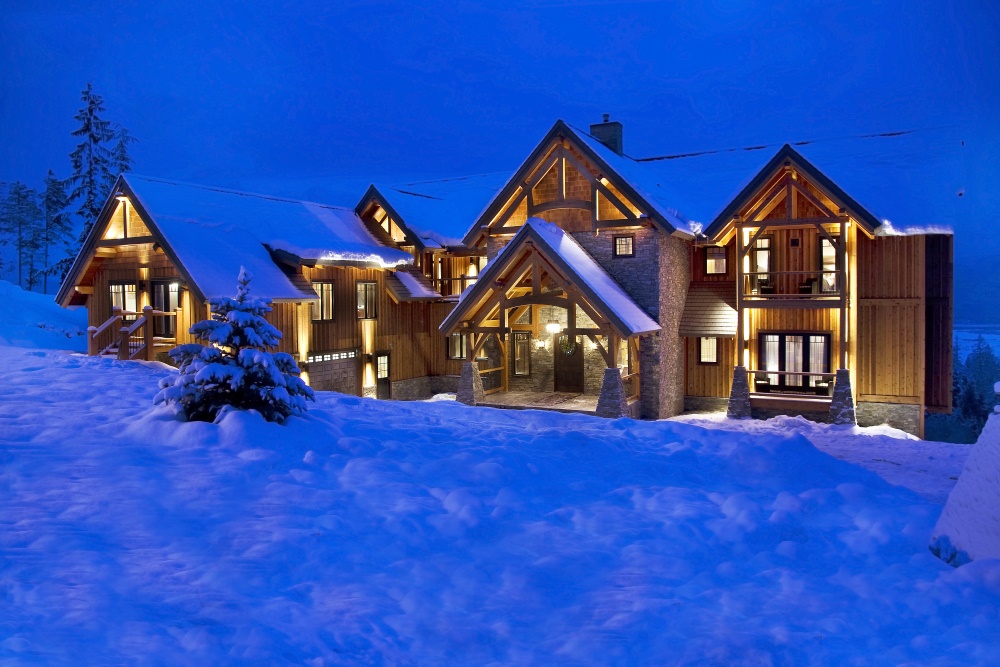
If you’re beginning to research timber homes, you’ll know that timber frame houses are eco-friendly, extremely durable and long-lasting. A timber frame allows for more insulation space, and the wood has natural insulating properties. The decorative aspect of a timber home adds tremendous curb appeal, which can increase its resale value. But what are the considerations for timber houses when it comes to seasonal weather? And how do cold climate conditions impact timber home sales?
How Good is a Timber Frame House for Cold Climate Conditions?
Properly designed, built and insulated, a timber frame home can be very warm and comfortable in the coldest winter conditions. In fact, wood is preferable to masonry and steel, due to its light weight, high strength, respectable R value (higher than steel, concrete and aluminum) and considerable thermal mass. Because it provides a higher thermal storage capacity that standard insulation, it takes longer to cool down or heat up. A timber frame acts as a buffer in the living space, slowing down temperature swings and reducing heating and cooling costs.
Additionally, the wood’s structure has very small air pockets that limit heat conduction. The timber frame home design provides more space for insulation than houses made with other materials like brick. This makes a timber frame house for cold climate conditions a very smart idea.
Does Wood Expand and Contract Through the Seasons?
Variances in temperature do not directly affect wood. The wood only reacts to the air moisture that’s present in the surrounding environment. However, moisture is a function of temperature changes. In the summer, humidity tends to be higher, causing wood to absorb moisture and expand. In the winter, the water will freeze, which can push apart wood fibers, possibly causing cracks.
Experienced timber frame companies use both air drying and kiln drying to prepare freshly harvested timber and remove any moisture. You can use a timber moisture meter to measure the percentage of moisture in the wood. If the wood is correctly prepared prior to building, kept relatively dry during the construction process, and the home is properly sealed and well-maintained, this is far less of an issue.
Timber Frame Homes in Colder Climates
If you’re going to be building a timber home in an area that’s subject to freezing temperatures and seasonal changes, planning prior to building is important. This is true regardless of the materials you’ll be using.
Here are some key considerations:
- Location and Orientation – If you can, choose a south-facing orientation for your timber frame home, to maximize the benefits of winter sunlight.
- Foundation Depth – For a timber frame building in a cold location, such as a northern U.S. state, foundation footings must be below the maximum frost depth.
- Built-Up Roof System – This roofing system, available in timber homes, provides vented air space above the insulation to minimize moisture buildup and deliver superior fire and uplift performance. It also protects the roof from extreme weather, UV and ice dams. A timber moisture meter can be used to check the moisture level.
- Structural Insulated Panels (SIPs) – These insulation systems deliver high energy efficiency and thermal value. They create a strong building envelope that seals the interior living environment from the outside, saving homeowners as much as 50% of heating and cooling costs compared to fiberglass insulation.
Energy Efficient Hybrid Timber Frame Homes for all Seasons
What is a hybrid timber frame house? It’s anything you want it to be! The beauty of handcrafted timbers is that they’re extremely versatile. Timber frame elements can be added to many other construction methods, including log, stick frame, concrete block, brick, poured cement, metal frame, straw bale and adobe. This makes timber great for any environment.
The heavy timbers can be used to provide optimal structural integrity and strength. Or, for architectural interest, they can be added as decorative features to conventional buildings. An expert timber frame company like Hamill Creek Timber Homes will design a custom plan for your location and preferences that will make the most efficient use of the timbers.
Is There Any Variance in Timber Home Sales Based on Climate?
Regarding climate, the main considerations for a home’s resale value are, as always, “location, location, location.” However, instead of a higher demand for oceanfront or lakefront properties, many homebuyers now prefer something inland, due to climate change concerns. U.S. News & World Report examined how real estate values could be impacted by a property’s proximity to water.
How do cold climate conditions impact timber home sales? If the home has been properly built by knowledgeable professionals, it won’t. In fact, a high-efficiency timber frame house that’s made to last for many years will be extremely attractive to prospective buyers, and this will boost the home’s resale value.
Timber Frame Buildings and Climate Change
Not only do timber frame houses provide the durability and energy efficiency that today’s homebuyers demand — timber frame structures may also help to solve the world’s climate change challenges. Reducing steel and concrete construction lowers carbon dioxide emissions (concrete alone is responsible for 4-8% of the world’s emissions). But it goes well beyond that. Timber buildings store the atmospheric carbon that is locked away in the trees. When new trees are planted to take the place of those that are harvested, the new trees absorb even more carbon dioxide. Cities like Seattle are already designing wooden skyscrapers that will sequester carbon, building a way to future sustainability.